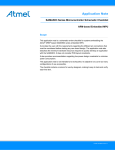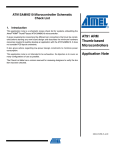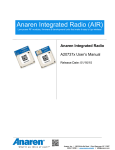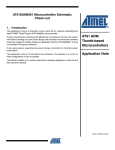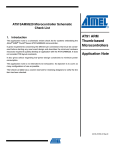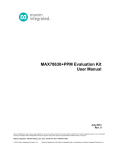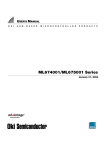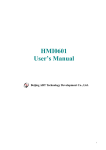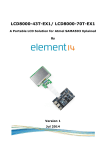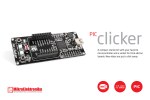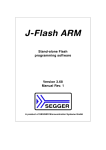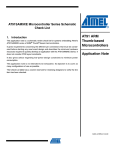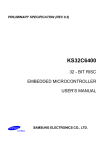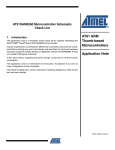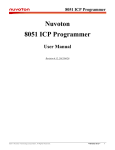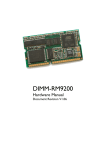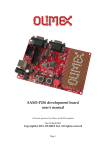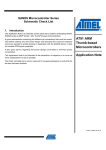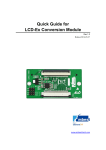Download AT91 ARM Thumb Microcontrollers Application Note
Transcript
AT91RM9200 Microcontroller Schematic Check List 1. Introduction This application note is a schematic review check list for systems embedding the Atmel® ARM® Thumb®-based AT91RM9200 microcontroller. It gives requirements concerning the different pin connections that must be considered before starting any new board design and describes the minimum hardware resources required to quickly develop an application with the AT91RM9200. This document does not consider PCB layout constraints. AT91 ARM Thumb Microcontrollers Application Note This application note is not intended to be exhaustive. Its objective is to cover as many configurations of use as possible. The Check List table has a column reserved for reviewing designers to verify the line item has been checked. 6323A–ATARM–03-Jul-07 2. Associated Documentation Before going further into this application note, it is strongly recommended to check the latest documents for the AT91RM9200 Microcontroller on Atmel’s Web site. Table 2-1 gives the associated documentation needed to support full understanding of this application note. Table 2-1. 2 Associated Documentation Information Document Title User Manual Electrical/Mechanical Characteristics Ordering Information Errata AT91RM9200 Product Datasheet Internal architecture of processor ARM/Thumb instruction sets Embedded in-circuit-emulator ARM9TDMI® Technical Reference Manual ARM920T™ Technical Reference Manual Evaluation Kit User Guide AT91RM9200-EK Evaluation Board User Guide Application Note 6323A–ATARM–03-Jul-07 Application Note 3. Schematic Check List ! Signal Name Pin Connection VDDCORE 1.65V to 1.95V Decoupling/Filtering capacitors (100 nF and 10µF)(1)(2) VDDIOM (3) 3.0V to 3.6V Decoupling/Filtering capacitors (100 nF and 10µF)(1)(2) Description Powers the device. Decoupling/Filtering capacitors must be added to improve startup stability and reduce source voltage drop. Powers External Bus Interface I/O pads. Decoupling/Filtering capacitors must be added to improve startup stability and reduce source voltage drop. Powers Peripheral I/O pads and USB transceivers. VDDIOP(3) 3.0V to 3.6V Decoupling/Filtering capacitors (100 nF and 10µF)(1)(2) VDDOSC 1.65V to 1.95V Decoupling capacitor (100 nF)(1)(2) Powers the Main Oscillator. VDDPLL 1.65V to 1.95V Decoupling capacitor (100 nF)(1)(2) Powers the PLL cells. GND Ground GND pins are common to VDDCORE, VDDIOM and VDDIOP pins. GND pins should be connected as shortly as possible to the system ground plane. GNDPLL PLL Ground GNDPLL pin is provided for VDDPLL pin. GNDPLL pin should be connected as shortly as possible to the system ground plane. GNDOSC Oscillator Ground GNDOSC pin is provided for VDDOSC pin. GNDOSC pin should be connected as shortly as possible to the system ground plane. Decoupling/Filtering capacitors must be added to improve startup stability and reduce source voltage drop. 3 6323A–ATARM–03-Jul-07 ! Signal Name Pin Connection Description Clock, Oscillator and PLL Main Oscillator Internal load capacitance: 20pF Crystal load capacitance to check (CCRYSTAL). AT91RM9200 20 pF GNDOSC Crystals between 3 and 20 MHz XIN XOUT Capacitors on XIN and XOUT (crystal load capacitance dependent) Main Oscillator in Normal Mode 1 Kohm resistor on XOUT only required for crystals with frequencies lower than 8 MHz. XIN XOUT 1K CL1 CL2 Note: XOUT cannot be used to drive another clock input. Example: for a 18.432 MHz crystal with a load capacitance CCRYSTAL= 25 pF, external capacitors are required: CL1= CL2 = 2x (25 pF-20 pF - Cboard) If Cboard is about 1.5pF CL1= CL2= 7pF. Refer to the electrical specifications of the AT91RM9200 datasheet. XIN XOUT Main Oscillator in Bypass Mode 4 XIN: external clock source XOUT: can be left unconnected 1.8V square wave signal (VDDOSC) External clock source up to 50 MHz Duty Cycle: 40 to 60% Refer to the electrical specifications of the AT91RM9200 datasheet for CIN and RIN values when using bypass mode. Application Note 6323A–ATARM–03-Jul-07 Application Note ! Signal Name Pin Connection Description Internal parasitic capacitance (including package): 6pF Supported Crystal with a load capacitance (CCRYSTAL) from 6pF up to 12.5 pF Maximal External Capacitor: CL1 = CL2 = 2 x (12.5 - 6 pF - Cboard)= 13 pF- 2xCboard. 32.768 kHz Crystal XIN32 XOUT32 Slow Clock Oscillator External Capacitors: CL1 is between XIN32 and Ground CL2 is between XOUT32 and Ground Note: Wired the 32K crystal as close as possible of the microcontroller. Do not forget to put a guard ring and avoid having any noisy line close to it. XOUT cannot be used to drive another clock input. AT91RM9200 XIN32 XOUT32 GNDOSC 32,768 Hz Crystal CL1 CL2 Example: for an 32.768 kHz crystal with a load capacitance of CCRYSTAL= 9 pF, Cboard= 1.5 pF, external capacitors are required: CL1 = CL2 =15pF. Refer to the electrical specifications of the AT91RM9200 datasheet. 5 6323A–ATARM–03-Jul-07 ! Signal Name Pin Connection Description See the Excel spreadsheet: “ATMEL_PLL_LFT_Filter_CALCULATOR_AT91_xxx.zip” (available in the software files on the Atmel Web site) allowing calculation of the best R-C1-C2 component values for the PLL Loop Back Filter. PLLRC PLL R C2 C1 GNDPLL PLLRCA PLLRCB PLL filter recommendations: Second-order filter Can be left unconnected if PLL not used. The Fn parameter represents the cutoff frequency at filter level. The higher the frequency, the better the PLL response time. The user should choose the highest frequency for this parameter, but be aware of the two following constraints: - Increasing Fn decreases the C1 and C2 values at filter level, whereas the resulting C1, C2 values must have values higher than the stray capacitances of the [package + layout]. - the Fn frequency must be at least 20 times lower than the input frequency. The good damping factor is the one closest to a value of 0.707. C1 ~ 10xC2 R, C1 and C2 must be placed as close as possible to the pins. 6 Application Note 6323A–ATARM–03-Jul-07 Application Note ! Signal Name Pin Connection Description (4) ICE and JTAG TCK Connected to ICE/JTAG Interface This pin is a Schmitt trigger input. Internal pull-up resistor. TMS Connected to ICE/JTAG Interface This pin is a Schmitt trigger input. Internal pull-up resistor. TDI Connected to ICE/JTAG Interface This pin is a Schmitt trigger input. Internal pull-up resistor. TDO Connected to ICE/JTAG Interface Output driven up to VVDDIOP RTCK Connected to ICE/JTAG Interface Output driven up to VVDDIOP NTRST To a reset circuitry NTRST must be driven at power up, even if JTAG port is not used Note: NTRST can be connected to NRST. JTAGSEL Must be tied to GND for normal operation and to VDDIOP to use Boundary scan features This pin is a Schmitt trigger input. Internal pull-up resistor. Reset/Test NRST Must be connected to reset circuitry. The reset delay must cover the 32Khz start up time (900ms) TST0, TST1 These two pins must be connected to ground for normal operation. PA31/BMS Application dependent. Must be tied to VDDIOP to boot from Embedded ROM. Must be tied to GND to boot from external memory. (EBI Chip Select 0). This pin is a Schmitt trigger input. Internal pull-up resistor. The BMS signal level during reset time boots from embedded ROM or from a 16-bit parallel Flash.This signal must be stable during reset. 7 6323A–ATARM–03-Jul-07 ! Signal Name Pin Connection Description PIO PAx PBx PCx PC6/NWAIT PDx(5) All PIOs are pulled-up inputs at reset except those which are multiplexed with the Address Bus signals that must be enabled as peripherals: PA30 (A23), PA31 (A24) and PC3 (A25). Application dependent. To reduce power consumption if not used, the concerned PIO can be configured as an output, driven at ‘0’ with internal pull-up disabled. (1) A pull up is mandatory on NWAIT if this pin in not used. If PC6/NWAIT is driven by an external device, user must ensure that the PC6/NWAIT pin is driven high as soon as the device is powered up. Application dependent. ETM features and 2nd USB HOST are available only on PIOD. Pull-up (100 KOhm) Multimedia Card Interface MCI PA28/MCCDA Pull-up to adjust according to MultiMedia Card specification or SD card Part1 physical layer specification MCIA Command Line PA8/MCCDB Pull-up to adjust according to MultiMedia Card specification or SD card Part1 physical layer specification MCIB Command Line EBI Data bus lines D0 to D15 are pulled-up inputs to VVDDIOM at reset. D0-D15 (D16-D31) A0-A22 (A23-A25) Application dependent. Application dependent. Note: Data bus lines D16 to D31 for SDRAM access. D16 to D31 are multiplexed with the PIOC controller. PIO input after reset. Address Bus (A0 to A25) A0 to A22: Address lines are driven to ‘0’ at reset. A23 to A25 Address bus lines are: - multiplexed with the PIOC controller. - PIO input after reset. SMC - SDRAM Controller - CompactFlash® Support See “External Bus Interface (EBI) Hardware Interface” on page 11. 8 Application Note 6323A–ATARM–03-Jul-07 Application Note ! Signal Name Pin Connection Description USB Host (UHP) No internal pull-down resistors. HDPA HDPB(5) Application dependent.(6) Typically, 15 kOhm resistor to GND. HDMA HDMB(5) Application dependent.(6) Typically, 15 kOhm resistor to GND. To reduce power consumption, if USB Host is not used, connect HDPA/HDPB to GND. No internal pull-down resistors. To reduce power consumption, if USB Host is not used, connect HDMA/HDMB to GND. USB Device (UDP) No internal pull-down, no internal pull-up resistors. DDP Application dependent.(7) DDM (7) To reduce power consumption, if USB Device is not used, connect DDP to VDDIOP. No internal pull-down, pull-up resistors. Notes: Application dependent. To reduce power consumption, if USB Device is not used, connect DDM to GND. 1. These values are given only as a typical example. 2. Decoupling capacitors must be connected as close as possible to the microcontroller and on each concerned pin. 100nF VDDCORE 100nF VDDCORE 100nF VDDCORE GND 3. The double power supplies VDDIOM and VDDIOP power the device differently when interfacing with memories or with peripherals. 4. It is recommended to establish accessibility to a JTAG connector for debug in any case. 5. Available only in the 256-ball RoHS BGA compliant Package 9 6323A–ATARM–03-Jul-07 6. Example of USB Host connection: A termination serial resistor (REXT) must be connected to HDPA/HDPB and HDMA/HDMB. A recommended resistor value is defined in the electrical specifications of the AT91RM9200 datasheet. 5V Type A Connector 10µF HDMA or HDMB 100nF 10nF REXT HDPA or HDPB REXT 15K 15K 7. Example of USB Device connection: Pull-up is active by default after reset (required by the boot application). No pull-down: DM is floating when the peripheral is not connected. The application shall monitor VBus and remove the pull-up when the host switch off. PIOy 15 K 5V Bus Monitoring 22K 3V3 PIOx USB Pull-up Active 1K5 1.5K 33 pF 27 R DDM 2 1 10µF DDP 27 R 15pF 10 3 Type B 4 Connector 15pF Application Note 6323A–ATARM–03-Jul-07 Application Note 4. External Bus Interface (EBI) Hardware Interface 4.1 Table 4-1 details the connections to be applied between the EBI pins and the external devices for each Memory Controller. Table 4-1. EBI Pins and External Device Connections Pins of the Interfaced Device Pin 8-bit Static Device Controller 2 x 8-bit Static Devices 16-bit Static Device SMC Burst Flash Device SDRAM BFC SDRAMC CompactFlash NANDFlash/ SmartMedia SMC D0 - D7 D0 - D7 D0 - D7 D0 - D7 D0 - D7 D0 - D7 D0 - D7 AD0 - AD7 D8 - D15 – D8 - D15 D8 - D15 D8 - D15 D8 - D15 D8 - 15 – D16 - D31 – – – – D16 - D31 – – A0/NBS0 A0 – NLB – DQM0 A0 – A1/NWR2/NBS2 A1 A0 A0 A0 DQM2 A1 – A2 - A9 A1 - A8 A1 - A8 A1 - A8 A0 - A7 A2 - A9 – A10 A10 A9 A9 A9 A8 A10 – A11 A11 A10 A10 A10 A9 – – – – – – A10 – – A12 A11 A11 A11 – – – A13 - A14 A12 - A13 A12 - A13 A12 - A13 A11 - A12 – – A15 A15 A14 A14 A14 – – – A16/BA0 A16 A15 A15 A15 BA0 – – A17/BA1 A17 A16 A16 A16 BA1 – – A18 - A20 A18 - A20 A17 - A19 A17 - A19 A17 - A19 – – – A21 A20 A20 A20 – – A2 - A9 SDA10 A12 A13 - A14 A21 A22 ALE A22 A21 A21 A21 – A23 - A24 A22 - A23 A22 - A23 A22 - A23 – – – A25 A25 A24 A24 A24 – CFRNW(1) – NCS0/BFCS CS CS CS CS – – – NCS1/SDCS CS CS CS – CS – – NCS2 CS CS CS – – – – NCS3/SMCS CS CS CS – – – A23 - A24 REG CLE (3) – (1) – NCS4/CFCS CS CS CS – – CFCS NCS5/CFCE1 CS CS CS – – CE1 – NCS6/CFCE2 CS CS CS – – CE2 – NRD/NOE/CFOE OE OE NWR0/NWE/CFWE NWR1/NBS1/CFIOR WE – OE – – OE WE (4) WE – – WE WE (4) NUB – DQM1 IOR – 11 6323A–ATARM–03-Jul-07 Table 4-1. EBI Pins and External Device Connections (Continued) Pins of the Interfaced Device 8-bit Static Device Pin Controller 2 x 8-bit Static Devices 16-bit Static Device SMC Burst Flash Device SDRAM BFC SDRAMC CompactFlash NANDFlash/ SmartMedia SMC NWR3/NBS3/CFIOW – – – – DQM3 IOW – BFCK – – – CK – – – BFAVD – – – AVD – – – BFBAA/SMWE – – – BAA – – WE BFOE – – – OE – – – BFRDY/SMOE – – – RDY – – OE BFWE – – – WE – – – SDCK – – – – CLK – – SDCKE – – – – CKE – – RAS – – – – RAS – – CAS – – – – CAS – – SDWE – – – – WE – – NWAIT – – – – – WAIT – Pxx (2) – – – – – CD1 or CD2 – Pxx (2) – – – – – – CE Pxx(2) – – – – – – RDY Notes: 1. Not directly connected to the CompactFlash slot. Permits the control of the bidirectional buffer between the EBI data bus and the CompactFlash slot. 2. Any PIO line. 3. The REG signal of the CompactFlash can be driven by any of the following address bits: A24, A22 to A11. 4. NWR1 enables upper byte writes. NWR0 enables lower byte writes. 5. AT91RM9200 Restrictions 5.1 Package Restrictions The AT91RM9200 is available in two packages: • 208-pin green PQFP, 31.2 x 31.2 mm, 0.5 mm pitch • 256-ball RoHS compliant BGA, 15 x 15 mm, 0.8 mm ball pitch The product features of the 256-ball BGA package are extended compared to the 208-lead PQFP package. The features that are available only with the 256-ball BGA package are: • Parallel I/O Controller D • ETM™ port with outputs multiplexed only on the PIO Controller D • a second USB Host transceiver, opening the Hub capabilities of the embedded USB Host. 12 Application Note 6323A–ATARM–03-Jul-07 Application Note 5.2 Multiplexing Restrictions: The AT91RM9200 features four PIO controllers: • PIOA and PIOB – Multiplexing I/O lines of the peripheral set • PIOC – Multiplexing the data bus bits 16 to 31 – Several External Bus Interface control signals. – Using PIOC pins increases the number of general-purpose I/O lines available but prevents 32-bit SDRAM memory access • PIOD – Available in the 256-ball BGA package option only, multiplexing outputs of the peripheral set and the ETM port 6. Internal Boot Program Constraints • PA31/BMS pin must be set to HIGH level to boot on AT91RM9200 internal boot ROM. • PLLB must be wired: – Associated LFT filter must be optimized for a 96 MHz running frequency with an accuracy of ± 0.25%. Use PLL Calculator tools (available on www.atmel.com) to estimate the filter. • A supported crystal is mandatory between XIN and XOUT (see Table 6-1). • Supported DataFlash devices (see Table 6-2) connected on NPCS0 or supported EEPROM devices (see Table 6-3). Note: The main oscillator cannot be bypassed. See the Boot Program section of the AT91RM9200 datasheet for more details on the boot program. Table 6-1. Supported Crystals (MHz) 3.0 3.2768 3.6864 3.84 4.0 4.433619 4.9152 5.0 5.24288 6.0 6.144 6.4 6.5536 7.159090 7.3728 7.864320 8.0 9.8304 10.0 11.05920 12.0 12.288 13.56 14.31818 14.7456 16.0 17.734470 18.432 20.0 Table 6-2. Device Supported DataFlash Devices Density Page Size (bytes) Number of Pages AT45DB011 1 Mbit 264 512 AT45DB021 2 Mbits 264 1024 AT45DB041 4 Mbits 264 2048 AT45DB081 8 Mbits 264 4096 13 6323A–ATARM–03-Jul-07 Table 6-2. Supported DataFlash Devices Device Density Page Size (bytes) Number of Pages AT45DB161 16 Mbits 528 4096 AT45DB321 32 Mbits 528 8192 AT45DB642 64 Mbits 1056 8192 The DataFlash must be connected to NPCS0 of the SPI. Table 6-3. Supported EEPROM Devices Device Size Organization AT24C16A 16 Kbits 16 bytes page write AT24C164 16 Kbits 16 bytes page write AT24C32 32 Kbits 32 bytes page write AT24C64 64 Kbits 32 bytes page write AT24C128 128 Kbits 64 bytes page write AT24C256 256 Kbits 64 bytes page write AT24C512 512Kbits 128 bytes page write Generally, serial EEPROMs have no identification code. The bootloader checks for an acknowledgment on the first read. The device address on the two-wire bus must be 0x0. The bootloader supports the devices listed in Table 6-3 6.1 Hardware Limitations of the Internal Boot Program The SPI and TWI drivers use several PIOs in alternate functions to communicate with devices. Care must be taken when these PIOs are used by the application. The devices connected could be unintentionally driven at boot time, and electrical conflicts between SPI or TWI output pins and the connected devices may appear. Table 6-4 contains a list of pins that are driven during the Boot Program execution. These pins are driven during the boot sequence for a period of about 6 ms if no correct boot program is found. The download through the TWI takes about 5 seconds for 64 Kbytes due to the TWI bit rate (100 Kbits/s). For the DataFlash driven by the SPCK signal at 12 MHz, the time required to download 64 Kbytes is reduced to 66 ms. Table 6-4. 14 Pins Driven during Internal Boot Program Execution Peripheral Pin PIO Line SPI MOSI PA1 SPI SPCK PA0 SPI NPCS0 PA3 TWI TWD PA25 Application Note 6323A–ATARM–03-Jul-07 Application Note Table 6-4. Pins Driven during Internal Boot Program Execution TWI TWCK PA26 DBGU DRXD PA9 DBGU DTXD PA10 The AT91RM9200 Boot program supports serial communication via the DBGU or DFU protocol via the USB Device Port. The USB pull-up must be active by default after reset. 7. External Boot Constraints PA31/BMS pin must be set to LOW level. Boot from an external 16-bit parallel Flash connected on NCS0. All initialization (PLL,SDRAM, SMC, etc.) is user dependent. 15 6323A–ATARM–03-Jul-07 8. Revision History Table 8-1. Revision History Doc. Rev Comments 6323A First issue 16 Change Request Ref. Application Note 6323A–ATARM–03-Jul-07 Headquarters International Atmel Corporation 2325 Orchard Parkway San Jose, CA 95131 USA Tel: 1(408) 441-0311 Fax: 1(408) 487-2600 Atmel Asia Room 1219 Chinachem Golden Plaza 77 Mody Road Tsimshatsui East Kowloon Hong Kong Tel: (852) 2721-9778 Fax: (852) 2722-1369 Atmel Europe Le Krebs 8, Rue Jean-Pierre Timbaud BP 309 78054 Saint-Quentin-enYvelines Cedex France Tel: (33) 1-30-60-70-00 Fax: (33) 1-30-60-71-11 Atmel Japan 9F, Tonetsu Shinkawa Bldg. 1-24-8 Shinkawa Chuo-ku, Tokyo 104-0033 Japan Tel: (81) 3-3523-3551 Fax: (81) 3-3523-7581 Technical Support AT91SAM Support Sales Contacts www.atmel.com/contacts/ Product Contact Web Site www.atmel.com www.atmel.com/AT91SAM Literature Requests www.atmel.com/literature Disclaimer: The information in this document is provided in connection with Atmel products. No license, express or implied, by estoppel or otherwise, to any intellectual property right is granted by this document or in connection with the sale of Atmel products. EXCEPT AS SET FORTH IN ATMEL’S TERMS AND CONDITIONS OF SALE LOCATED ON ATMEL’S WEB SITE, ATMEL ASSUMES NO LIABILITY WHATSOEVER AND DISCLAIMS ANY EXPRESS, IMPLIED OR STATUTORY WARRANTY RELATING TO ITS PRODUCTS INCLUDING, BUT NOT LIMITED TO, THE IMPLIED WARRANTY OF MERCHANTABILITY, FITNESS FOR A PARTICULAR PURPOSE, OR NON-INFRINGEMENT. IN NO EVENT SHALL ATMEL BE LIABLE FOR ANY DIRECT, INDIRECT, CONSEQUENTIAL, PUNITIVE, SPECIAL OR INCIDENTAL DAMAGES (INCLUDING, WITHOUT LIMITATION, DAMAGES FOR LOSS OF PROFITS, BUSINESS INTERRUPTION, OR LOSS OF INFORMATION) ARISING OUT OF THE USE OR INABILITY TO USE THIS DOCUMENT, EVEN IF ATMEL HAS BEEN ADVISED OF THE POSSIBILITY OF SUCH DAMAGES. Atmel makes no representations or warranties with respect to the accuracy or completeness of the contents of this document and reserves the right to make changes to specifications and product descriptions at any time without notice. Atmel does not make any commitment to update the information contained herein. Unless specifically provided otherwise, Atmel products are not suitable for, and shall not be used in, automotive applications. Atmel’s products are not intended, authorized, or warranted for use as components in applications intended to support or sustain life. © 2007 Atmel Corporation. All rights reserved. Atmel®, logo and combinations thereof, DataFlash ® and others are registered trademarks, SAMBA ™ and others are trademarks of Atmel Corporation or its subsidiaries. ARM ®, the ARM Powered ® logo, Thumb® and others are registered trademarks or trademarks of ARM Limited. Other terms and product names may be the trademarks of others. 6323A–ATARM–03-Jul-07


















